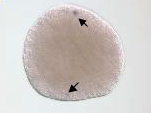SICB Annual Meeting 2012
January 3-7, 2012
Charleston, SC
Symposium: Poecilogony, polymorphism or polyphenism: A window on larval evolutionary transitions in marine invertebrates.

Brooded
larvae of Pygospio elegans, a poecilogonous polychaete (J.
Kesäniemi)
Poecilogonous species are capable of producing different larval forms (e.g., free-swimming, planktotrophic larvae as well as brooded, lecithotrophic larvae in marine invertebrates). Such species provide a unique opportunity to investigate the cellular, developmental, and genetic mechanisms leading to larval transitions, as well as the selective pressures and possible ecological circumstances that might be involved. Poecilogony can be a controversial topic, since it is difficult to identify and characterize with certainty: does poecilogony represent true polymorphisms with differing genetic bases, or is it a case of developmental polyphenism with phenotypes determined by plastic responses to environmental cues?
We think that an integrative approach is the best way to achieve an understanding of developmental mode transitions, and that poecilogonous species provide the most appropriate models for study. We will host a symposium highlighting recent research on poecilogonous species using a variety of approaches: developmental, genomic and transcriptomic, population genetic, comparative phylogenetic, and ecological. The symposium will foster communication among researchers from these diverse fields of study and encourage further studies of poecilogony that integrate methods and perspectives from across sub-disciplines.
Co-Organizers
Emily Knott, University of Jyväskylä, Finland
Damhnait McHugh, Colgate University, USA
Funding
Society for Integrative and Comparative Biology, Divisions: DEDB, DEE, DIZ
|
|
|
 |
NSF 
Speakers
S3-1.1 Wednesday, Jan. 4, 08:00 KNOTT, K.E.*; MCHUGH, D.:
Poecilogony, polymorphism or polyphenism: a window on larval evolutionary transitions in marine invertebrates
S3-1.2 Wednesday, Jan. 4, 08:30 COLLIN, R:
What Can “Intermediates” Tell Us About Evolutionary Transitions Between Modes of Invertebrate Development?
S3-1.3 Wednesday, Jan. 4, 09:00 VENDETTI, J. E. *; KRUG, P. J. :
Origins of poecilogony and shifts in larval type in photosynthetic sea slugs: a phylogenetic perspective
S3-1.4 Wednesday, Jan. 4, 09:30 KRUG, P.J.*; GORDON, D.:
Ecological triggers and evolutionary consequences of alternative larval types in sea slugs
S3-1.5 Wednesday, Jan. 4, 10:30 SCHULT, N.*; MCHUGH, D.:
Streblospio benedicti (Spionidae, Annelida) as a model organism for the study of larval evolutionary transitions
S3-1.6 Wednesday, Jan. 4, 11:00 ROCKMAN, Matthew:
Looking for poecilogony in the Streblospio benedicti genome
S3-1.7 Wednesday, Jan. 4, 11:30 GIBSON, G D:
Poecilogony in the polychaete Polydora cornuta: A potential polyphenism that requires decisions, decisions, decisions.
S3-2.1 Wednesday, Jan. 4, 13:00 OYARZUN, FX*; GRüNBAUM, D:
Two reproductive strategies and their implications for population dynamics: An individual-based model of the poecilogonous spionid Boccardia proboscidea
S3-2.2 Wednesday, Jan. 4, 13:30 ZAKAS, Christina*; WARES, John P:
The consequences of a poecilogonous life history for dispersal ability, genetic structure and gene flow in coastal populations of the polychaete Streblospio benedicti
S3-2.3 Wednesday, Jan. 4, 14:00 KESäNIEMI, J.E.*; KNOTT, K.E.:
Developmental mode polymorphism and population connectivity in the polychaete Pygospio elegans
S3-2.4 Wednesday, Jan. 4, 14:30 , :
Discussion
A Panel Discussion will follow the scheduled talks and be open to all attendees. Complementary Sessions may be organized after abstract submission.

Expression of Tbx6 in mesodermal precursor cells of a Stage 2 large-egg larva of Streblospio benedicti (Annelida) (D. McHugh and N. Schult, unpub.)

